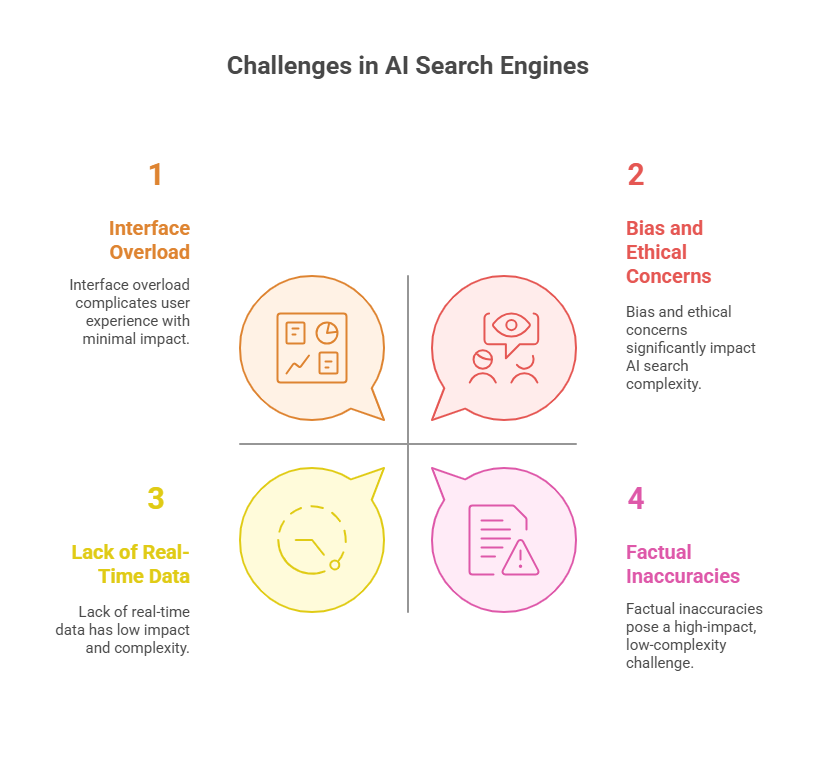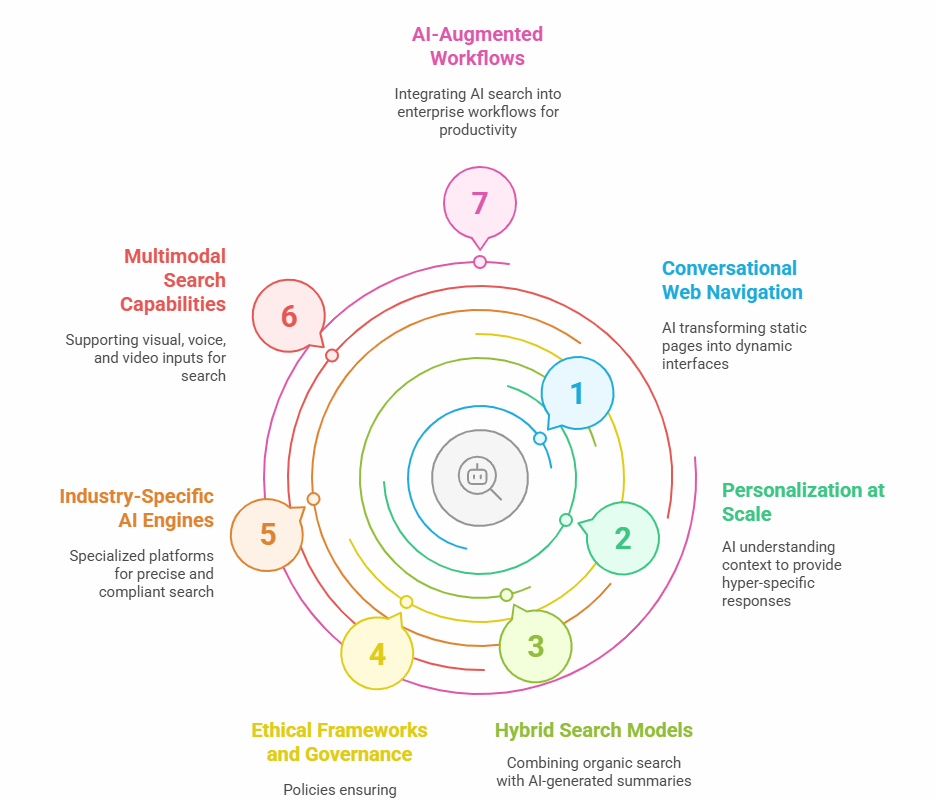The Rise of AI Search Engines: Redefining How We Discover Information

Artificial Intelligence is transforming every aspect of the digital landscape – search included. Traditional search engines like Google and Bing are no longer the sole gatekeepers of online knowledge. Instead, AI search engines are reshaping how users ask questions, receive answers, and interact with content. These platforms blend language models with search algorithms to deliver summarized, context-aware results, drastically reducing the need to scroll through endless links. As AI search becomes mainstream, it’s crucial for individuals and businesses alike to understand how these tools work, where they excel, and what the future holds.
What Are AI Search Engines?
AI search engines represent a transformative evolution in the way we seek, access, and process online information. Unlike traditional search engines that deliver a list of blue hyperlinks based on keyword relevance, AI-powered engines aim to generate a direct, well-contextualized answer to a user’s query. These answers are synthesized from multiple credible sources using large language models (LLMs) like GPT or Claude. The goal is not just to deliver information, but to understand the user’s intent and serve it conversationally, accurately, and efficiently.
What makes AI search engines stand out is their ability to interpret nuanced questions, remember conversational context, and return synthesized responses that feel more human and intuitive. Instead of “search and click,” users now experience “ask and receive.” AI search is also multimodal – supporting images, voice, and documents – and built to evolve with the user over time, making the search experience increasingly intelligent and personal.
These engines are also designed to streamline the decision-making process. Whether it’s finding the right product, understanding a complex topic, or comparing services, AI search engines offer real-time summarization, quick comparisons, and follow-up capabilities—all in one place. This marks a major shift from passive retrieval to active, guided discovery.
Subtopics:
Natural Language Understanding
AI engines are trained on vast datasets of written and spoken language. This allows them to understand nuances in tone, slang, or phrasing. Even if a user inputs an incomplete or vague query, the AI can often decipher the intent behind it and return an accurate, relevant response.
Summarized Responses
Instead of requiring users to scan multiple links, AI engines offer summarized responses drawn from reputable sources. These summaries often blend definitions, examples, and implications – especially helpful for academic, technical, or first-time inquiries.
Follow-Up Interaction
One of the biggest differentiators is conversational memory. AI search engines allow users to build on prior queries without needing to retype context. This enables fluid, multi-step exploration of topics that would normally require multiple distinct searches.
Multimodal Inputs
Advanced AI search tools now accept image uploads, voice queries, and even documents. For example, a user can upload a PDF and ask questions about its contents, or speak a question aloud while on the go – making search more accessible than ever.
Source Attribution
Despite the convenience of summarization, reputable AI search engines maintain transparency by citing their sources. This supports user trust and gives the option to explore original data or articles in depth.
Leading AI Search Engines and Their Strengths
The AI search market is rapidly diversifying, with both tech giants and startups launching their own approaches to intelligent querying. Each engine brings a different philosophy – some prioritize conversational depth, while others focus on blending AI with traditional search results. Understanding the nuances between them can help users choose the best tool for their needs and businesses to decide where to optimize content.
These engines aren’t just about convenience; they’re redefining content discovery across research, commerce, and everyday problem-solving. Some excel in mobile-first experiences, while others lean heavily into academic and professional use cases. Below, we outline the current leaders in the space and what sets them apart.
Subtopics:
Perplexity AI
Perplexity combines chatbot fluency with serious research power. It allows users to ask complex or layered questions and receive summarized responses that often include citations and visual data. Its ability to organize searches into sessions or “collections” makes it ideal for long-term projects or knowledge-based workflows. It also supports document uploads on Pro plans, enabling internal search across personal files.
Google AI Overviews
Google’s AI Overviews integrate tightly with its traditional search engine, appearing only when confident in the topic’s factual stability. These summaries are generated by its Gemini model and provide a helpful starting point. While it doesn’t allow follow-up dialogue directly in the SERP, users can shift to Google’s Gemini chatbot for conversational refinement. Google’s vast data index ensures timely and contextually rich responses.
Arc Search
Arc Search is built specifically for mobile users who want quick, synthesized answers. Its “Browse for Me” feature essentially automates the research journey, opening links, reading them, and generating a comprehensive summary webpage. This is especially useful for users who want multi-source insights without navigating each page manually. However, it’s currently limited to iOS devices and doesn’t support live data refresh.
Bing AI
Microsoft’s Bing AI provides instant summaries alongside its traditional search results and integrates with Copilot for follow-up conversations. It shows promise in product discovery and general search but still struggles with precision in live event coverage. Bing’s interface includes visual sidebars and interactive cards, but the cluttered layout and inconsistent AI quality can hinder user experience.
You.com
You.com pioneered AI-powered search interfaces and remains a flexible tool with different response modes. Its “Research” mode generates long-form answers, while “Genius” offers creative takes with images or infographics. Despite a solid feature set, its search index often lags behind on fast-changing topics, making it less suitable for real-time queries or news tracking.
Ready to make your digital presence AI-search-ready?
Partner with Neuronimbus to future-proof your business with intelligent, discoverable, and user-first solutions.
Let’s build smarter together.Use Cases and Benefits of AI Search Engines
AI-powered search engines are rapidly redefining how people and organizations access, consume, and act on information. Their use cases stretch far beyond casual web browsing. For individuals, these tools save time, improve accuracy, and simplify learning. For businesses, they offer smarter workflows, better user experiences, and enhanced decision-making capabilities through instant data synthesis and contextual relevance.
Subtopics:
Research & Education
AI search engines are becoming indispensable tools in classrooms, labs, and corporate training programs. Students use them to get instant explanations on complex topics. Academics summarize long research papers into digestible takeaways. Researchers run hypothesis-based queries and explore emerging trends without having to dig through dozens of journal databases. This streamlining of research workflows enhances learning efficiency and encourages self-directed exploration.
Content Creation
Writers, editors, and digital marketers now rely on AI search for everything from SEO optimization to campaign ideation. The ability to generate quick stats, historical insights, keyword trends, or product comparisons empowers content creators to move faster while maintaining quality. It reduces the friction of early-stage ideation and supports more agile publishing timelines, especially in fast-paced environments like newsrooms or digital agencies.
Customer Support
Enterprises are integrating AI search into customer-facing platforms, enabling instant, context-aware support without live agents. AI can pull answers from help centers, manuals, and FAQs, providing users with quick resolutions while reducing operational costs. This also enables 24/7 self-service support, a key differentiator in sectors like telecom, SaaS, and e-commerce.
E-Commerce & Product Discovery
In online retail, AI-powered search enriches the customer journey by turning product discovery into an informed and personalized experience. Rather than relying on filters and drop-down menus, users can simply describe their needs. The engine then delivers summaries, comparison charts, expert reviews, and even purchase suggestions – compressing the decision-making process.
Accessibility & Inclusion
AI search tools are helping bridge the digital divide. Features like voice input, image-based search, and multilingual query support allow users with visual impairments, limited literacy, or language barriers to access the internet meaningfully. As natural language models grow smarter, search becomes more inclusive, accommodating a broader range of communication styles and needs.
Limitations and Challenges in AI Search

Despite their growing popularity, AI search engines have limitations that can’t be overlooked. From trust concerns to incomplete data, these challenges must be addressed before widespread adoption becomes safe and reliable.
Subtopics:
Factual Inaccuracies
AI models sometimes “hallucinate”- fabricating details that appear plausible but are incorrect. This happens because the models are trained to predict likely-sounding text, not validate facts. For industries like healthcare, legal services, or financial reporting, this makes it essential to cross-check any AI-generated output with trusted sources.
Lack of Real-Time Data
Not all AI search engines are connected to live, dynamic datasets. As a result, they may provide outdated or lagging information when queried about ongoing events. This limits their effectiveness in time-sensitive domains like news, stock markets, or emergency updates, where precision and timeliness are critical.
Attribution & Copyright
AI-generated summaries can obscure the original source of the content, raising ethical and legal questions. Content creators may not receive proper credit or traffic from engines that paraphrase without linking back. This has led to rising tensions between AI platforms and publishers who argue it disrupts the content economy.
Search Depth vs. Brevity
AI search responses are designed for speed and convenience. However, their brevity can flatten complexity, especially in nuanced areas like law, medicine, or academic research. Users needing a deeper understanding often still require access to primary sources, full articles, or expert consultation.
Interface Overload
Some AI platforms try to integrate search, chat, media, and productivity tools into a single dashboard. While ambitious, this often results in cluttered interfaces and information overload. Clean, intuitive design is key to ensuring users aren’t overwhelmed and can access relevant information quickly.
Bias and Ethical Concerns
AI models are only as unbiased as the data they’re trained on. Many search engines still reflect societal biases in their answers – whether it’s gender stereotypes, cultural inaccuracies, or politically skewed narratives. Developers must consistently evaluate training data and outputs to ensure ethical alignment and fairness.
Dependence on External Sources
AI search engines depend heavily on external websites and databases. If their source index is outdated or limited, the responses may lack credibility or relevance. Moreover, paywalled or specialized databases often remain inaccessible, reducing the tool’s utility for in-depth professional research.
Security and Privacy
Storing and processing queries on external servers raises privacy concerns—especially for sensitive or personal searches. Organizations and users must assess how data is collected, stored, and shared, particularly in regulated industries like healthcare or finance.
Inconsistent Source Transparency
Some AI engines provide excellent source citations; others are vague or omit them entirely. Lack of clear sourcing limits user trust and makes it harder to validate critical information. Improved citation practices are essential to build long-term user confidence in AI-generated responses.
Over-Reliance on AI
As users get accustomed to convenience, there’s a growing risk of over-reliance on AI engines. When users stop validating sources or thinking critically about answers, misinformation can spread more easily. Education and digital literacy efforts must evolve alongside these tools to encourage informed use rather than blind trust.
What the Future Holds for AI Search

AI search is in its infancy, but its trajectory promises a radical transformation of how people interact with information, brands, and digital ecosystems. As natural language processing (NLP), multimodal learning, and real-time data integration evolve, search will shift from being a tool into an intuitive, personalized assistant embedded into daily digital life.
Subtopics:
Conversational Web Navigation
Websites are already moving away from rigid navigation bars. In the future, AI will turn static pages into dynamic interfaces where users can ask, request, and receive insights on the fly. This conversational layer will replace search bars with intelligent agents that surface information, troubleshoot problems, and even complete transactions through dialogue.
Personalization at Scale
The future of AI search will revolve around understanding context – not just intent. Engines will learn individual preferences, tone, industry jargon, and behavioral history to serve responses that are hyper-specific. This will help professionals, students, and casual users get exactly what they need, cutting through the noise of generic answers.
Hybrid Search Models
AI won’t entirely replace traditional search – it will complement it. We’ll see hybrid models dominate, where organic search rankings coexist with generative summaries. These systems will enable users to toggle between summarized insights and source-level depth depending on their need for speed versus comprehensiveness.
Ethical Frameworks and Governance
The rapid expansion of AI search requires ethical regulation. Expect stronger policies around attribution (so publishers are credited), misinformation control, source bias mitigation, and data privacy. Governments and tech alliances will push for transparent models that respect both creators and users in this new paradigm.
Industry-Specific AI Engines
One-size-fits-all AI search will give way to specialized platforms. Legal teams will use AI engines trained on case law; doctors will consult engines trained on clinical trials and treatment protocols. These vertical-specific systems will ensure higher precision, compliance, and utility – especially in high-stakes domains.
Multimodal Search Capabilities
Text-only input is becoming outdated. Future AI search engines will support visual, voice, and video inputs; allowing users to search by showing, describing, or recording queries. This is crucial for industries like fashion, architecture, or repair services, where image-based queries often yield more accurate results than text alone.
AI-Augmented Workflows
Enterprise search will be deeply embedded into internal workflows. From legal teams finding clauses to sales teams summarizing leads, AI search will move from the browser to the dashboard, supercharging daily productivity and strategic decision-making alike.
How Can Neuronimbus Help You?
As AI search redefines how users discover, interact with, and trust digital content, Neuronimbus equips businesses with the technology and expertise to not only adapt—but lead. We help future-ready organizations build AI-integrated digital experiences by transforming traditional websites into intelligent interfaces, optimizing content for AI visibility, and developing enterprise-grade internal search systems powered by natural language processing and custom logic. Whether your goal is discoverability in next-gen engines like Perplexity and Gemini, chatbot-enabled navigation, or intelligent knowledge portals, Neuronimbus offers the strategic insight and engineering power to bring those solutions to life—securely, scalably, and intelligently.
 Back
Back


